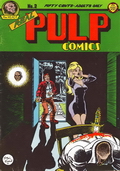real pulp comics

Real Pulp Comics
Print Mint (1971-1973)
Real Pulp Comics is a terrific two-issue anthology that came along in the heyday of underground comics and during the peak of Roger Brand as both a comics creator and an editor. Brand had a vibrant creative mind and encyclopedic knowledge of comic book history, which made it all the more sad that he was also a relentless alcoholic and drug addict who died at the ridiculously young age of 42 in 1985. But from the late ’60s through the mid ’70s, Brand was one of the most entertaining and productive characters in the underground.
Brand’s expertise about 1930s and ’40s comic art, popular culture and pulp fiction was a direct influence on the themes he set for both issues of Real Pulp Comics. In a cartoon on the inside front cover of the first issue, Brand introduces the character Pulpman, who asks, “Youse rememba all de crime movies, sund’y funnies, comic books, radio sloot’s, and all de rest o’ dat ol’ nostalja-crap o’ de 1930s and ’40s?”
Real Pulp Comics delivers just that type of vacuous-yet-beloved entertainment, but with a decidedly underground twist.
Brand was one of the first to recognize the talents of Art Spiegelman, just 22 years old and working at Topps Bubble Gum when he began developing the first of three memorable stories about “The Viper,” two of which appear in Real Pulp (the third one was in Bijou Funnies #7). Speigelman’s early style and subject matter would rapidly evolve before producing the Pulitzer Prize-winning Maus, but Brand had a feeling from the beginning: “Of all of us…if anybody is going to make it…if one of us is going to get famous…it’s Artie. Art Spiegelman will do something big time.” (Quoted by Paul Rodgers.)
Real Pulp Comics #1 is also historically important for featuring the first appearance of Bill Griffith’s Zippy (the pinhead) character. In 1970, as Brand recruited artists for the first issue, he asked Griffith to produce “some kind of love story, but with really weird people. Do something in the Young Lust vein, maybe a threesome between two normal people and one really weird person.”
Griffith used that advice and some inspiration from the 1932 movie Freaks to produce “I Gave My Heart to a Pinhead, and He Made a Fool Out of Me.” In his debut, Zippy looks different than he would in the decades to follow; he looks less intelligent, less attractive and more like Schlitzie, the microcephalic (pinhead) who appeared in Freaks. It would not be long before Griffith made slight revisions to Zippy’s appearance and sustained great success with his signature character for over 40 years.
If only Roger Brand had found such success as well. The world would be much richer with him still in it. But then, as most of Brand’s friends have attested, once he began that downhill slide with the booze and the drugs, there was really nothing that could stop him. At least we do have comic gems like Real Pulp Comics, Tales of Sex and Death and Ban Zai! to remind us of how good Brand really was when he was in his prime.


